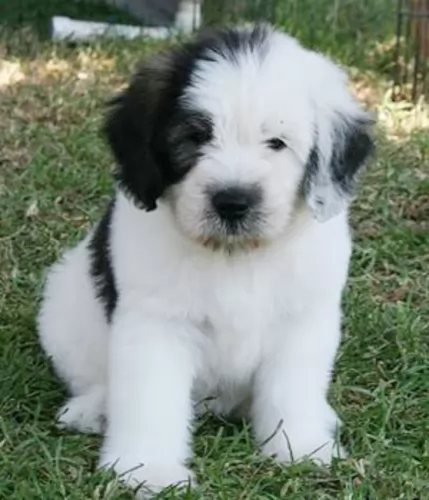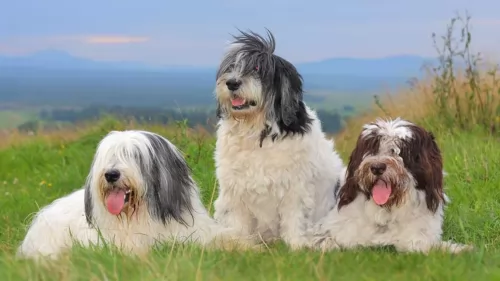 MyDogBreeds
MyDogBreeds Polish Lowland Sheepdog is originated from Poland but Braque Francais is originated from France. Polish Lowland Sheepdog may grow 19 cm / 7 inches shorter than Braque Francais. Polish Lowland Sheepdog may weigh 32 kg / 70 pounds lesser than Braque Francais. Both Polish Lowland Sheepdog and Braque Francais has same life span. Both Polish Lowland Sheepdog and Braque Francais has almost same litter size. Polish Lowland Sheepdog requires Moderate maintenance. But Braque Francais requires Low maintenance
Polish Lowland Sheepdog is originated from Poland but Braque Francais is originated from France. Polish Lowland Sheepdog may grow 19 cm / 7 inches shorter than Braque Francais. Polish Lowland Sheepdog may weigh 32 kg / 70 pounds lesser than Braque Francais. Both Polish Lowland Sheepdog and Braque Francais has same life span. Both Polish Lowland Sheepdog and Braque Francais has almost same litter size. Polish Lowland Sheepdog requires Moderate maintenance. But Braque Francais requires Low maintenance
 Hailing from Poland, the Polish Lowland Sheepdog is believed to have descended from herding dogs as well as the Puli and Tibetan Terrier.
Hailing from Poland, the Polish Lowland Sheepdog is believed to have descended from herding dogs as well as the Puli and Tibetan Terrier.
Later these dogs were bred with local Scottish dogs to bring about Scottish herding dogs, the Bearded Collie. The dog was accepted by the Federation Cynologique Internationale in 1959. In 2001, the American Kennel Club recognized the Polish Lowland Sheepdog as a breed in the Herding Group.
 Braque Francais was at first one general breed of hounds in the Gascognes and Pyrenees Mountains areas of France. The one breed became two. Known as the Braque Francais Gascognes and the Braque Francais Pyrenees - two separate breeds of very alike dogs. The Gascognes is a lot less common than his smaller brother. Not very much is known about the beginnings of these two strains of Braque Francais as the breed has been around since at least the 15th century. Because the Braque Francais was exported or taken to so many different countries in the 15th-18th centuries, a lot of the origins of the breeds were lost. A major bloodline search was The conducted in the 19th century and found that these were two very distinct breeds of dog.
Braque Francais was at first one general breed of hounds in the Gascognes and Pyrenees Mountains areas of France. The one breed became two. Known as the Braque Francais Gascognes and the Braque Francais Pyrenees - two separate breeds of very alike dogs. The Gascognes is a lot less common than his smaller brother. Not very much is known about the beginnings of these two strains of Braque Francais as the breed has been around since at least the 15th century. Because the Braque Francais was exported or taken to so many different countries in the 15th-18th centuries, a lot of the origins of the breeds were lost. A major bloodline search was The conducted in the 19th century and found that these were two very distinct breeds of dog.
It is known that France was the birthplace of this breed and it was developed because of a need for a tracker that could point, flush and retrieve. The Braque Francais Gascogne probably came from the south of France. It is related to the German Shorthair Pointer and the English Pointer as well. Having existed since the 15th century, he was the father of all pointing dogs in France. By the 17th century the breed had grown enough to be called the “old style Braque Francais”,
Though the origin of the breed is not known there are of course several theories about it. The most prevalent belief is that the Braque Francais Gascogne is a descendent of the Chien d’Oysel, a spaniel breed of medium size and white or brown with brown markings. The Chien d’Oysel is an ancient breed used for hunting prior to the 13th century. Hunters crossed the Chien with local dogs on a routine basis.
Braque Francais came out of these breedings. It was probably French Scent hounds that created the larger size of the Gascogne. This also increased the stamina and strength of the Gascogne as opposed to the Pyrenees. There was also a mixing in of the Grand Bleu De Gasgogne and the Petit Bleu De Gasgogne.
The other prominent theory is that this breed the Gasgogne was actually developed from the Portugese, Spanish and Italian pointers rather than the French dogs. These dogs originated not with the Chien d’Oysel but with the scent hounds. From these dogs came the Spanish and English Pointers. All that is truly known is that all of these types of dogs were present in Europe by the fifteenth century and were moved among countries and cross bred regularly. However in the part of France called the Central Pyrenees region and in a small southern part of France the original, old style Braque Francais was pure bred. This aspect of the breed contributed to the development of all of the French pointers and European shorthaired dogs. By the end of the 1800’s today’s breed was developed.
In 1850 the first Braque Francais breed club was established and in the breed standards for both dogs followed in 1880. They were then registered in the French Kennel Club and the International Kennel Club (FCI). The French Kennel Club does not allow dogs with any common ancestors in Generations 1-3 into the Club in order to keep out the practice of inbreeding. In Canada only the Gascogne is recognized and the United States’ United Kennel Club (UKC) recognizes both. The American Kennel Club (AKC) does not recognize either.
With most local regions and countries choosing their local dogs over other breeds, the Braque Francais Gascogne has become fairly rare outside of France where the breed was the most popular gun dog throughout the 1700’s. The Gascogne was mostly a dog of the hunting nobility because of its size and food needs. Following the French Revolution, the breed fell off dramatically, while the smaller Pyrenees continued to thrive. This was because in the Pyrenees Mountains and the Southwestern region of Gascony, the English Pointer never supplanted the Braque Francais.
The Second World War was brutal to the Braque Francais Gascognes and as it recovered it became much less common than its sister breed. Today it is found almost exclusively in France.
 The Polish Lowland Sheepdog is a medium-sized dog. Both males and females stand between 42cm to 50 cm in height and they weigh roughly between 14 and 23kg.
The Polish Lowland Sheepdog is a medium-sized dog. Both males and females stand between 42cm to 50 cm in height and they weigh roughly between 14 and 23kg.
The dog has a double coat which can mostly be white, cream, gray, brown and black. The underdoat is soft and dense with the top coat being straight or wavy and being medium length.
There is quite a bit of hair around the facial area. The eyes are alert and brown and the ears medium size, high set and then drooping down. The tail has always been attractively docked, giving the dog an attractive, compact look but these days it is often just left long.
Lively, bright as a button, clever, social and feisty, the Polish Lowland Sheepdog is easy to train, becoming obedient and well balanced. The Polish Lowland Sheepdog is such a self confident dog and he will fit happily into life in the city or the countryside, loving spending time with his human family.
 The Braque Francais Gascogne is a larger dog than the Pyrenees breed and is a very handsome dog. Both have a deep chest, a solid bodies, strong and slender legs and are well-proportioned. They have padded, round paws and a large brown head with floppy ears. The muzzle is a pointed block and he has a scissors bite, with a black nose and dark or amber eyes. The eyes are very expressive and round. The tail can be straight and long, or it can be docked. They are tall and athletic.
The Braque Francais Gascogne is a larger dog than the Pyrenees breed and is a very handsome dog. Both have a deep chest, a solid bodies, strong and slender legs and are well-proportioned. They have padded, round paws and a large brown head with floppy ears. The muzzle is a pointed block and he has a scissors bite, with a black nose and dark or amber eyes. The eyes are very expressive and round. The tail can be straight and long, or it can be docked. They are tall and athletic.
 The PON is an independent, self-willed dog but he can also be entertaining and amusing. He is a social, friendly dog but for many people, his long hair and grooming requirement might prove to be a bit of a handful.
The PON is an independent, self-willed dog but he can also be entertaining and amusing. He is a social, friendly dog but for many people, his long hair and grooming requirement might prove to be a bit of a handful.
Your dog is energetic, cheerful and playful and when he isn’t around, it will be like some sunshine has gone out of your life. He is faithful and loving towards his human family but is aloof towards strangers. Bring one of these dogs into your home and you’re guaranteed to have a remarkable friend and pet for many years.
 This is a working breed, but they are nevertheless friendly and loyal to their families. They want to please their people and are usually docile. They love kids and are good as a first ever dog. They are friendly and even-tempered. They tolerate people they do not know but can be shy and are not guard dogs. instead they are loving, affectionate and people oriented. They need to be with their families and never left outside alone. They can develop separation anxiety.
This is a working breed, but they are nevertheless friendly and loyal to their families. They want to please their people and are usually docile. They love kids and are good as a first ever dog. They are friendly and even-tempered. They tolerate people they do not know but can be shy and are not guard dogs. instead they are loving, affectionate and people oriented. They need to be with their families and never left outside alone. They can develop separation anxiety.
 These dogs are generally healthy and the dog’s life expectancy is about 12 years. Nonetheless there are some problems to be aware of. For instance, with this dog, hip dysplasia is a real problem.
These dogs are generally healthy and the dog’s life expectancy is about 12 years. Nonetheless there are some problems to be aware of. For instance, with this dog, hip dysplasia is a real problem.
The Orthopedic Foundation of America evaluated the hip X-rays of hundreds of these dogs and found a large percentage were dysplastic.
Hereditary eye disease can also occur with this dog. Macular degeneration is a common eye disorder that can cause central vision loss. Many genetic abnormalities can cause degeneration of the image forming part of the eye. Unfortunately these conditions can result in total blindness. Parts of the retina can also degenerate with age.
Skin allergies are also an ever present threat with your dog. Itchiness and pain can be a nightmare for your pet and scratching and licking brings no relief – just aggravates the condition. You will certainly need to get your pet to the vet as skin allergies and skin diseases can make your beloved canine miserable.
 The Braque Francais is a fairly healthy breed. They are susceptible to certain health conditions that most dogs of their size and working history are susceptible to. These include Patellar luxation which seems to be one of the most common problems for them. They also can have hip and/or elbow dysplasia, aortic stenosis which is a narrowing of the aorta, and some eye issues such as ectropion, entropion, and PRA (Progressive Retinal Atrophy as well as cataracts.
The Braque Francais is a fairly healthy breed. They are susceptible to certain health conditions that most dogs of their size and working history are susceptible to. These include Patellar luxation which seems to be one of the most common problems for them. They also can have hip and/or elbow dysplasia, aortic stenosis which is a narrowing of the aorta, and some eye issues such as ectropion, entropion, and PRA (Progressive Retinal Atrophy as well as cataracts.
 Your Polish Lowland Sheepdog is like a big Bear and his long, shaggy coat will require regular brushing, otherwise it could become full of burrs and grass.
Your Polish Lowland Sheepdog is like a big Bear and his long, shaggy coat will require regular brushing, otherwise it could become full of burrs and grass.
Many people prefer to take their dogs to a grooming parlor where the hair is cut, the nails trimmed, the teeth cleaned and the ears checked.
Provide your Sheepdog with a nice warm, dry cozy spot that is his and where he can quietly retreat.
If your Polish Lowland Sheepdog spends time outdoors, make sure he has access to both shade, sun and shelter in case it rains. There must always be a bowl of fresh water outdoors too.
It is better to give your adult Polish Lowland Sheepdog 2 smaller helpings of food as opposed to one big bowl. Puppies will need 4 bowls of food a day. Two bowls will ensure your dog doesn’t gobble up his food and create digestive problems and bloat.
High-quality dry dog food will provide a balanced diet, but you want to make it a little more delicious for him occasionally by mixing in chopped up boiled chicken, brown rice, sweet potatoes, carrots and spinach. Just a tad of raw meat occasionally can also be of huge benefit.
Fresh, cool water should always be available around the clock. Be sure to keep his food and water dishes clean.
Have your dogs spayed or neutered if you don’t want them to have puppies.
 This is a high energy, working dog with a need for a high-quality energy food or raw food that you make up yourself. Be sure to include chicken, beef and fish. Feed him about 3 cups once a day or 1.5 cups twice a day.
This is a high energy, working dog with a need for a high-quality energy food or raw food that you make up yourself. Be sure to include chicken, beef and fish. Feed him about 3 cups once a day or 1.5 cups twice a day.
In addition to the conditions listed above, his long floppy ears can lead to ear infections if not cared for. Wash them out daily. He is also susceptible to bloat so don’t feed him large meals and don’t let him exercise or work right before or right after exercise.
These dogs have a variety of hunting skills. They are not only pointers but can flush, trail and retrieve. The Gascogne is not as quick as the Pyrenees. They need a lot of exercise daily or they need a hunting job. They would do well with barn hunt, lure coursing and free play in an off leash fenced in area. If they don’t get rid of their energy, they can be destructive. They were bred to hunt and cannot resist the chase,